McClintock Residence
Key Facts
• Carefully crafted simplicity and efficiency closely fitting function
• The property has no mains power and all energy is generated on site
Project Data
Location: Koah (nr Kuranda), QLD, Australia
Year completed: 2007
OVERVIEW
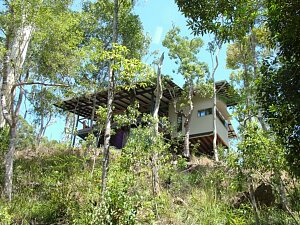 The client approached the architect with a design for a small studio dwelling to be constructed on their acreage property bordering the Clohesy River on the edge of Barron Gorge national park. The property had no mains power or water, but had an existing shed (which the clients were living in) and solar power system.
The client approached the architect with a design for a small studio dwelling to be constructed on their acreage property bordering the Clohesy River on the edge of Barron Gorge national park. The property had no mains power or water, but had an existing shed (which the clients were living in) and solar power system.
The owners had conceived their design based on a kit home, but had ideas for a diagonally split roof which they couldn’t resolve with the kit home supplier. The core of their design – open plan bedroom/kitchen/dining, one bathroom, walk-in robe and summer and winter decks with a split roof form – was made into a rational design taking account of breeze paths, sun angles and functional space forms.
Each space was carefully crafted to closely fit its function, eliminating wasted construction and providing just the right amount of light, ventilation and space. The resulting form embeds in the natural surrounds and creates the peaceful ambience the clients desired.
PLANNING AND MANAGEMENT
The owner builder was supported by Battistin Builders who completed a large part of the construction work.
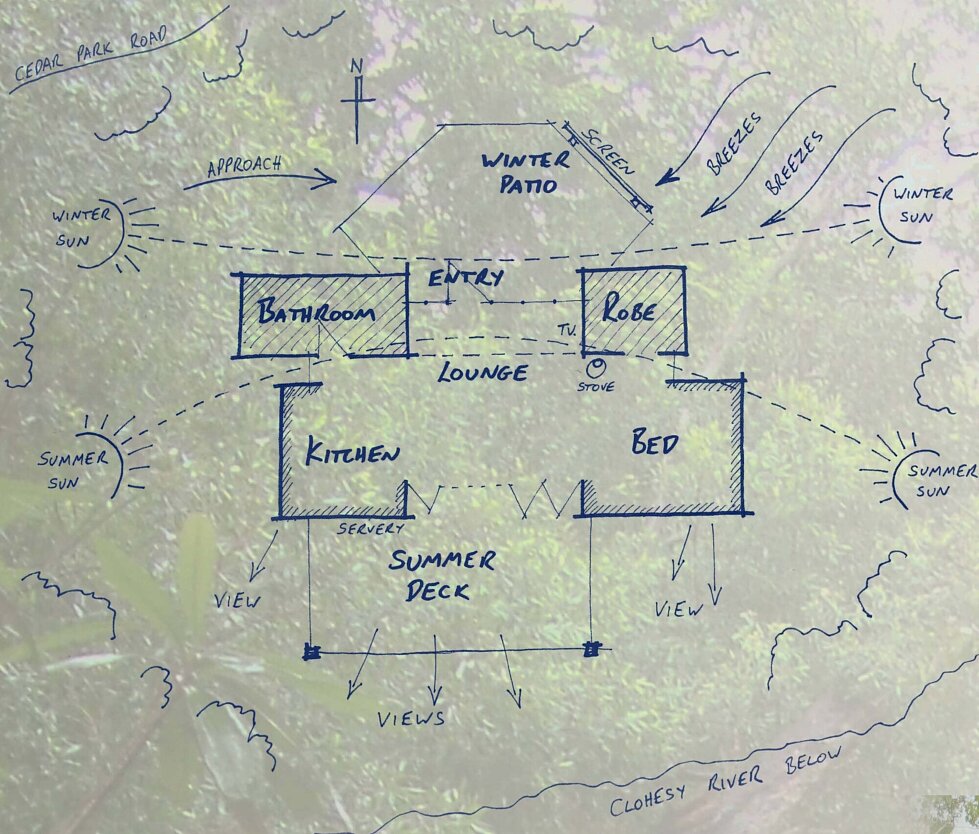
SITE
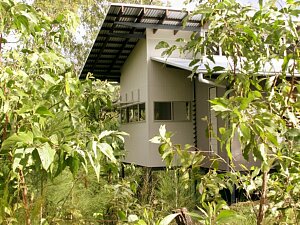 The site consists of scrubby eucalypt forest with minimal clearing. The available site area for building had a substantial slope, which was used to good advantage by the lightweight construction. Minimal benching was required to place the water tanks beneath the dwelling, and access is at ground level on the north side. The site slopes down to the south toward the river, affording high level views from the south (summer) deck down to the water below. This deck looks into the lower canopy of the surrounding eucalypts.
The site consists of scrubby eucalypt forest with minimal clearing. The available site area for building had a substantial slope, which was used to good advantage by the lightweight construction. Minimal benching was required to place the water tanks beneath the dwelling, and access is at ground level on the north side. The site slopes down to the south toward the river, affording high level views from the south (summer) deck down to the water below. This deck looks into the lower canopy of the surrounding eucalypts.
DESIGN
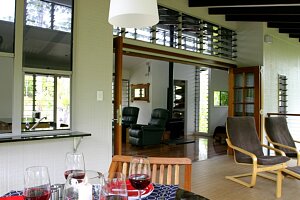 The design is characterised by simplicity and efficiency. No elaborate or wasteful devices have been used, just careful consideration of the spatial requirements and composition to maximise the ambient benefits.
The design is characterised by simplicity and efficiency. No elaborate or wasteful devices have been used, just careful consideration of the spatial requirements and composition to maximise the ambient benefits.
The design is split into 2 forms – North and South, with the main circulation access crossing these resulting in 4 resting places – bathroom and robe to the north, and bedroom and kitchen in the south. The circulation spaces are formed through the winter patio, lounge, dining space and summer deck.
The robe and bathroom are located in the north form as this has the lower roof and more enclosed feel, whilst the kitchen and bedroom benefit from the cooling high ceiling and clerestory glazing from the high roof. The main roof falls down to the southern edge of the summer deck to maximise the shading from the summer sun, and to direct views down to the river.
MATERIALS
 Material selections were kept lightweight for ease of construction on the site. Steel and fibre-cement claddings were selected for termite resistance and lower fire risk. Heavy materials were used for the winter patio to the north side of the house to maximise thermal mass for the cooler winter months when the house is heated by a wood fired combustion heater – providing a warm retreat in the winter.
Material selections were kept lightweight for ease of construction on the site. Steel and fibre-cement claddings were selected for termite resistance and lower fire risk. Heavy materials were used for the winter patio to the north side of the house to maximise thermal mass for the cooler winter months when the house is heated by a wood fired combustion heater – providing a warm retreat in the winter.
ENERGY
The property has no mains power, so all energy is generated on site by the photo voltaic solar system. Hot water is also solar. Backup power is provided with a small petrol generator.
Power requirements are minimised through excellent passive ventilation, carefully designed shading to all glazed areas (supplemented by shade from the forest), and abundant natural light provided by the windows and amplified by the deliberately small footprint.
WATER AND WASTE
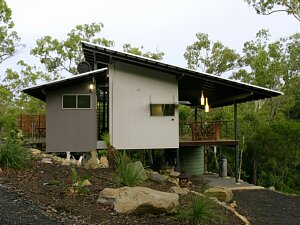 All the rainwater from the roof is collected on site in 2x 22,000 litre tanks located under the house in the undercroft space.
All the rainwater from the roof is collected on site in 2x 22,000 litre tanks located under the house in the undercroft space.
OWNERS/USERS STATEMENT
“The house is easy to clean and low maintenance. The form of the building with lots of openings and the high ceiling with louvre windows keep it cool. It works.
The only thing I would change are the windows near the bed, which the architect designed to be quite low so you could see down to the river from lying in bed, but the builder talked me into putting them up at a normal height. It would have been nicer to have them down low.”
PROJECT TEAM
Base building architect/ designer: CA Architects - Stuart Withrington
Structural engineer: CMG
Builder: Battistin Builders



